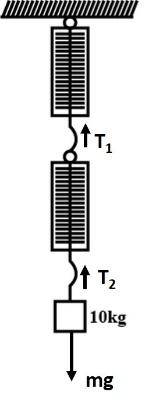
A block of mass 10Kg is suspended through two light spring balances as shown in figure.

A. Both scales will read 10 kg.
B. Both scales will read 5 kg.
C. The upper scale will read 10 kg and the lower zero.
D. The readings may be anything but their sum will be 10 kg.
Answer
219.6k+ views
Hint:The quantity tension is basically a reactive force of the spring or thread or rope due to the action of pulling by an object of mass m with acceleration a. It is in the opposite direction to the direction of displacement or acceleration of the object. Hence, tension through both balances will be the same.
Formula used:
\[T = mg\]
where T = tension, m = mass of the object and g = acceleration due to gravity = \[\]9.8 \[m{s^{ - 2}}\].
Complete step by step solution:
Consider the first spring to be the one attached to the wall and let the second spring be that to which the block of mass is directly attached. Let m’ be the mass of the second spring to which the mass is directly attached. Let tension through the first spring be \[{T_1}\] and the tension through the second spring be \[{T_2}\].

Image: free body diagram for force and tension due to mass = 10 kg
For equilibrium condition to prevail,
\[{T_1} = \left( {m' + m} \right)g\]- (1)
And \[{T_2} = mg\] - (2)
According to the question, as both springs are given to be light, their weight can be neglected.
Hence, \[{T_1} = mg\]= \[{T_2}\]
Hence both balances will read mass as 10 kg.
Hence option (A) is the correct answer.
Note: In case of horizontal displacement or using horizontal component of displacement, \[T = ma\]. In case of vertical displacement as given in the question, we use g = acceleration due to gravity = 9.8 \[m{s^{ - 2}}\]as the acceleration whose sign (positive or negative) is determined by the direction of motion (upwards or downwards).
Formula used:
\[T = mg\]
where T = tension, m = mass of the object and g = acceleration due to gravity = \[\]9.8 \[m{s^{ - 2}}\].
Complete step by step solution:
Consider the first spring to be the one attached to the wall and let the second spring be that to which the block of mass is directly attached. Let m’ be the mass of the second spring to which the mass is directly attached. Let tension through the first spring be \[{T_1}\] and the tension through the second spring be \[{T_2}\].

Image: free body diagram for force and tension due to mass = 10 kg
For equilibrium condition to prevail,
\[{T_1} = \left( {m' + m} \right)g\]- (1)
And \[{T_2} = mg\] - (2)
According to the question, as both springs are given to be light, their weight can be neglected.
Hence, \[{T_1} = mg\]= \[{T_2}\]
Hence both balances will read mass as 10 kg.
Hence option (A) is the correct answer.
Note: In case of horizontal displacement or using horizontal component of displacement, \[T = ma\]. In case of vertical displacement as given in the question, we use g = acceleration due to gravity = 9.8 \[m{s^{ - 2}}\]as the acceleration whose sign (positive or negative) is determined by the direction of motion (upwards or downwards).
Recently Updated Pages
Chemical Equation - Important Concepts and Tips for JEE

JEE Main 2022 (July 29th Shift 1) Chemistry Question Paper with Answer Key

Conduction Explained: Definition, Examples & Science for Students

Analytical Method of Vector Addition Explained Simply

Atomic Size - Important Concepts and Tips for JEE

JEE Main 2022 (June 29th Shift 1) Maths Question Paper with Answer Key

Trending doubts
JEE Main 2026: Application Form Open, Exam Dates, Syllabus, Eligibility & Question Papers

Understanding Uniform Acceleration in Physics

Derivation of Equation of Trajectory Explained for Students

Hybridisation in Chemistry – Concept, Types & Applications

Understanding the Angle of Deviation in a Prism

Understanding Collisions: Types and Examples for Students

Other Pages
JEE Advanced Marks vs Ranks 2025: Understanding Category-wise Qualifying Marks and Previous Year Cut-offs

Units And Measurements Class 11 Physics Chapter 1 CBSE Notes - 2025-26

NCERT Solutions For Class 11 Physics Chapter 8 Mechanical Properties Of Solids

Motion in a Straight Line Class 11 Physics Chapter 2 CBSE Notes - 2025-26

NCERT Solutions for Class 11 Physics Chapter 7 Gravitation 2025-26

Mechanical Properties of Fluids Class 11 Physics Chapter 9 CBSE Notes - 2025-26




